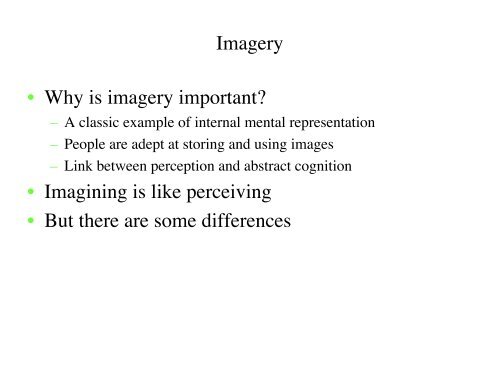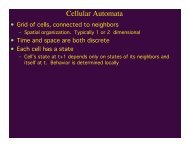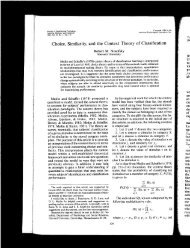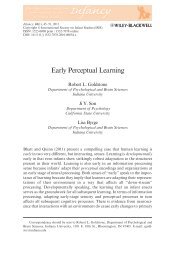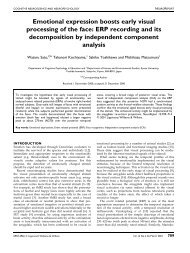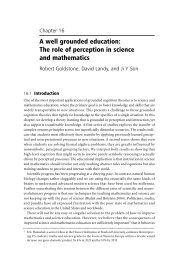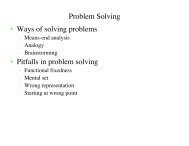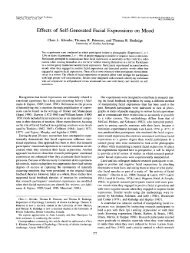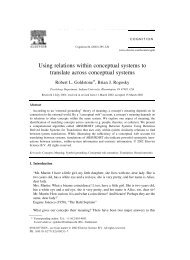Imagery ⢠Why is imagery important? ⢠Imagining is like perceiving ...
Imagery ⢠Why is imagery important? ⢠Imagining is like perceiving ...
Imagery ⢠Why is imagery important? ⢠Imagining is like perceiving ...
You also want an ePaper? Increase the reach of your titles
YUMPU automatically turns print PDFs into web optimized ePapers that Google loves.
<strong>Imagery</strong><br />
• <strong>Why</strong> <strong>is</strong> <strong>imagery</strong> <strong>important</strong><br />
– A classic example of internal mental representation<br />
– People are adept at storing and using images<br />
– Link between perception and abstract cognition<br />
• <strong>Imagining</strong> <strong>is</strong> <strong>like</strong> <strong>perceiving</strong><br />
• But there are some differences
<strong>Imagining</strong> <strong>is</strong> <strong>like</strong> <strong>perceiving</strong><br />
• Functional similarities between pictures and images<br />
– Scanning<br />
– Rotating<br />
– Zooming-in<br />
• <strong>Imagery</strong> and language processes are different<br />
– Property verification (Kosslyn)<br />
– Interference between task and responses (Brooks)<br />
• Physiological evidence for common areas<br />
• Similar patterns of sensitivity<br />
• Can’t always tell image from actual picture
Scanning
Rotation
Zooming in
Zooming in
Answer by consulting your image<br />
Do cats have backs<br />
Do cats have claws<br />
Answer any way you want
Brooks’ interference study<br />
Task<br />
“For each edge, <strong>is</strong> it on<br />
the extreme top or<br />
bottom of the shape”<br />
Hard<br />
Method of responding<br />
Point to Yes/No on a page<br />
“For each word, <strong>is</strong> it<br />
a noun or not”<br />
Easy<br />
Hard<br />
Easy<br />
Say Yes or No<br />
<strong>Imagery</strong> and verbal abilities use different resources<br />
Good performance if task and response do not use the same resource
Similar patterns of sensitivity in percepts and images
Reality monitoring<br />
Can’t always tell real presentation from image
Differences between pictures and images<br />
• Mental d<strong>is</strong>tortions<br />
– Influence of boundaries on perception<br />
– Simplification of object models<br />
• Images can’t be reinterpreted<br />
– Images = perception + interpretation
D<strong>is</strong>tortions in images
Is X east/west of Y<br />
Congruent better than<br />
Homogeneous<br />
Homogeneous better than<br />
incongruent<br />
Information about larger regions<br />
(counties) influences<br />
judgments about smaller<br />
regions (cities)
Images can’t be reinterpreted<br />
What would th<strong>is</strong> object look <strong>like</strong> if<br />
rotated 90 degrees clockw<strong>is</strong>e<br />
People usually cannot respond “seahorse” if using memorized image<br />
People usually can respond “seahorse” if asked to draw image (from<br />
memory), physically rotate paper, and then reinterpret drawing<br />
Information <strong>is</strong> present in image, but hard to reinterpret flexibly


